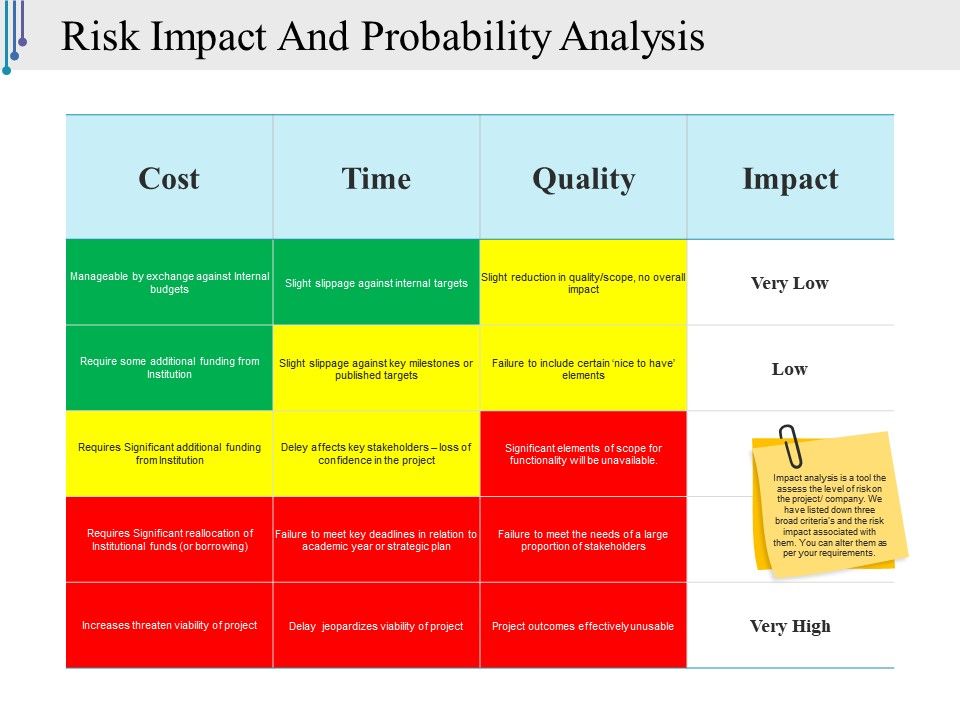

- #RISK PROBABILITY IMPACT RESPONSE HOW TO#
- #RISK PROBABILITY IMPACT RESPONSE SOFTWARE#
- #RISK PROBABILITY IMPACT RESPONSE PLUS#
The first step is identifying all potential risks that could affect your project’s timeline or goals. The following steps will help you competently reduce and control all potential project risks. While it’s impossible to eliminate all risks, it’s indeed possible to limit their impact by managing them. Risks are an inherent part of any project. Examples include inaccurate requirements gathering from clients and different interpretations of the project scope among team members. Examples include varying raw material prices and changing the supplier of a crucial product component.Īmbiguity risks: These risks stem from the lack of clarity in project requirements that can lead to misinterpretations or mistakes. Variability risks: These risks are associated with fluctuations or inaccuracies in demand, supply, quality, price, etc., that can impact the project outcome. Examples of such uncertainties include natural calamities, wars, and changes in government policies.
#RISK PROBABILITY IMPACT RESPONSE PLUS#
Overall project risk comprises an aggregate of individual risks plus all other sources of project uncertainty. Overall project risks: These risks refer to the impact of uncertainty on the overall project. Examples include not having enough resources for a job and having to deal with sick leaves or employee time-off during peak season. Individual project risks: These are individual risk events that, if they occur, can affect the quality, cost, time, and/or scope of a project.

We’ve also added examples to explain the risks better. Let’s go through some of the most common types of project risks that you may encounter.
#RISK PROBABILITY IMPACT RESPONSE SOFTWARE#
Leverage integrated risk management (IRM) software to determine potential project risks early on, prioritize high-impact risks, and improve decision-making by consolidating risk management processes and data analysis.Ĭommon types of project management risks (with examples) If a risk assessment indicates that the impact of a particular threat will be severe, you should take necessary steps to avoid or mitigate that threat in advance.įor any project, there are many risks to consider, but the most influential ones are related to project schedule, cost, quality, technology, and resources. It helps prioritize your project management efforts. Why do you need project risk management?Īs a project manager, identifying and assessing risks is an essential part of your job. It focuses on risk reduction by identifying the root causes of risks and minimizing their impact, if not completely eliminating them. Simply put, project risk management is a process that aims to reduce project risks that have already occurred, are occurring, or are likely to occur in the future. Project risk management is the process of identifying, assessing, and responding to unexpected risks that might affect your project's goals and progress. For instance, a key supplier going out of business and a key team member leaving your organization-both qualify as project risks. Risks could be due to internal or external factors.

Project risk is any potential issue that could negatively impact the successful completion of your projects.
#RISK PROBABILITY IMPACT RESPONSE HOW TO#
Dive deep and learn how to reduce risks to keep your projects on track! But first, let’s understand the nitty-gritty of project risks. In this guide, we explain everything you need to know about project risk management.


 0 kommentar(er)
0 kommentar(er)
